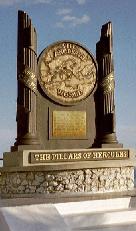Pillars of Hercules
|
|
de:Säulen des Herakles eo:Heraklaj Kolonoj fr:Colonnes d'Hercule la:Columnae Herculis nl:Zuilen van Hercules
Pillars of Hercules is the ancient name given to the promontories that flank the entrance to the Straits of Gibraltar. They are Gibraltar in Europe and Monte Hacho in Ceuta in Africa. The Jebel Musa, west of Ceuta, is sometimes considered one of the Pillars.
| Contents |
Mythological significance
The Pillars of Hercules has its origin in Greek mythology.
The creation of the pillars
After killing Medusa, Perseus took the head of the Gorgon with him to distant lands and reached the western end of the Earth where the sun sets - the land where Atlas the Titan resided and raised magical golden apples. Perseus wished to rest in Atlas' garden and asked him for food but Atlas - fearing that the hero would steal his magical fruit - refused and sent Perseus away. Perseus then showed Atlas the head of Medusa and the Titan turned into a giant mountain - his hair turning into a great forest, his shoulders into cliffs and his bones into solid rock.
The naming of the pillars
When Hercules had to perform twelve labours, one of them was to fetch the Cattle of Geryon and bring it to Eurystheus. On his way to the island of Erytheia he had to cross the mountain that was once Atlas. Instead of climbing the great mountain, Hercules split it in half using his indestructible mace. By doing so, he connected the Atlantic Ocean to the Mediterranean Sea and formed the Strait of Gibraltar. One part of the split mountain is currently called Gibraltar and the other is Monte Hacho. These two mountains taken together were since then known as the Pillars of Hercules.
The pillars as portals
The pillars are also mentioned at some places as portals, or gates to different locations on Earth. When the Carthaginian admiral Himilco was sent to explore the area of the Muddy Sea (a shallow plateau that lies to the southwest of the Pillars) his report included the words "Many seaweeds grow in the troughs between the waves, which slow the ship like bushes {...} Here the beasts of the sea move slowly hither and thither, and great monsters swim languidly among the sluggishly creeping ships" (Rufus Festus Avienus) This description accurately resembles the Sargasso Sea rather than the Muddy Sea.
The Pillars appear as supporters of the coat of arms of Spain. The motto Plus Ultra (Latin for further beyond) indicates the desire to see the Pillars as an entrance to the rest of the world rather than as a gate to the Mediterranean Sea. It also indicates the overseas possessions that Spain once had.
Phoenician connection
Near Gades/Gadeira (modern Cádiz, just beyond the strait) was the westernmost temple of Tyrian Heracles (Melqart), near the eastern shore of the island (Strabo 3.5.2–3). Strabo notes (3.5.5–6) that the two bronze pillars within the temple, each 8 cubits high, were widely proclaimed to be the true Pillars of Heracles by many who had visited the place and had sacrificed to Heracles there. But Strabo believes the account to be fraudulent, in part noting that the inscriptions on those pillars mentioned nothing about Heracles, speaking only of the expenses occurred by the Phoenicians in their making. The columns of the Melqart temple at Tyre were also of religious significance.
In Dante's Inferno
When describing his circles of hell, Dante mentions Ulysses and his voyage past the Pillars of Hercules (once considered the western end of the world). Ulysses justifies endangering his sailors by the fact that his goal is to gain knowledge of the unknown. After five months of navigation in the ocean, Ulysses detects the Purgatory but encounters a whirlwind that sinks his ship.
In music
The Russian bard Alexander Gorodnitsky wrote a song under a similar title in 1965, while sailing past the Strait of Gibraltar on one of his many sea voyages. The song makes numerous references to Ulysses' voyages in the area and other sections of The Odyssey


